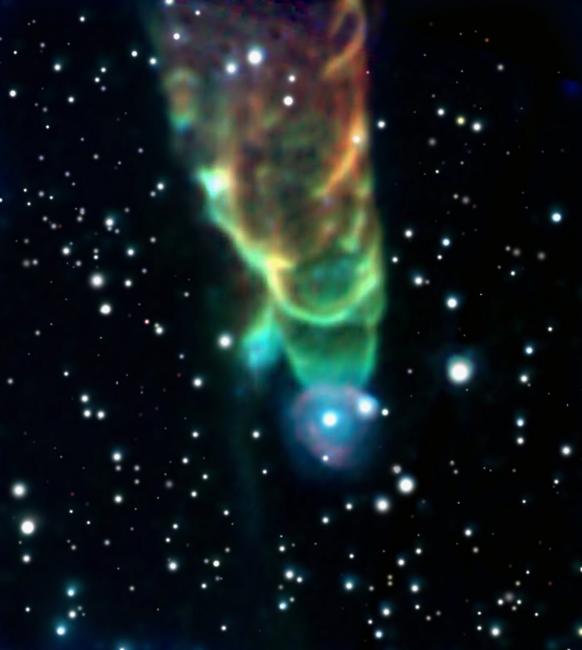
Washington, DC
While examining a region where new stars are forming with NASA's Spitzer Space Telescope, astronomers found a surprise - an object that looks like a giant tornado in space. The apparent tornado is shaped by a cosmic jet packing a powerful punch as it plows through clouds of interstellar gas and dust. They released an image of the "tornado" today at the 207th meeting of the American Astronomical Society in Washington, DC.
"When I first saw the image of this tornado-like object, I was amazed," said Giovanni Fazio of the Harvard-Smithsonian Center for Astrophysics (CfA). "In the thousands of Spitzer images we've looked at, we've never seen anything like this before."
The "tornado" is actually a shock front created by a jet of material flowing downward through the field of view. A still-forming star located off the upper edge of the image generates this outflow. The jet slams into neighboring dust clouds at a speed of more than 100 miles per second, heating the dust to incandescence and causing it to glow with infrared light detectable by Spitzer. The triangular shape results from the wake created by the jet's motion, similar to the wake behind a speeding boat.
The outflow that powers the "tornado," designated Herbig-Haro 49/50, had been observed before, most recently using a ground-based telescope at the Cerro Tololo Inter-American Observatory. Intrigued by the shock emission spotted at Cerro Tololo, astronomers then targeted Spitzer onto the region and were thrilled to see a spectacular spiral structure emerge.
"The helical morphology of the `tornado' makes it unique," said astronomer John Bally (University of Colorado), lead author on the research.
The scientists could only speculate about the source of the spiral appearance. Magnetic fields throughout the region might have shaped the object. Alternatively, the shock might have developed instabilities as it plowed into surrounding material, creating eddies that give the "tornado" its distinctive appearance.
Most striking about the color-coded infrared image is the color gradient from one end of the "tornado" to the other. The astronomers believe that the blue color at the tornado's tip results from high molecular excitation at the head of the shock. Those high excitation levels generate more short-wavelength emission, shown as blue in this color-coded image. Molecular excitation levels decrease away from the head of the bow shock; therefore the emission is at longer wavelengths, colored red here.
The star at the tip of the "tornado," which appears to be surrounded by a faint halo, might be a chance superposition along our line of sight. However, the star instead might be physically associated with the "tornado." In that case, the halo likely is due to the outflow running into circumstellar material.
HH 49/50 is located in the Chamaeleon I star-forming complex, a region containing more than 100 young stars. Most of the new stars are smaller than the sun, although some are more massive. Visible-light observations have found a number of outflows in the region, however most of those outflows have no infrared counterpart.
"To really nail our understanding of the 'tornado,' we need to conduct infrared spectroscopy at moderately high resolution," said Bally. "More observations should help us to unravel its mysterious nature."
JPL manages the Spitzer mission for NASA's Science Mission Directorate. Science operations are conducted at the Spitzer Science Center at the California Institute of Technology in Pasadena. NASA's Goddard Space Flight Center built Spitzer's Infrared Array Camera, which took this image. The instrument's principal investigator is Giovanni Fazio of CfA.
Headquartered in Cambridge, Mass., the Harvard-Smithsonian Center for Astrophysics (CfA) is a joint collaboration between the Smithsonian Astrophysical Observatory and the Harvard College Observatory. CfA scientists, organized into six research divisions, study the origin, evolution and ultimate fate of the universe.
David A. Aguilar
Director of Public Affairs
Harvard-Smithsonian Center for Astrophysics
617-495-7462
daguilar@cfa.harvard.edu
Christine PulliamPublic Affairs Specialist
Harvard-Smithsonian Center for Astrophysics
617-495-7463
cpulliam@cfa.harvard.edu
Whitney Clavin
Jet Propulsion Laboratory
818-354-4673
whitney.clavin@jpl.nasa.gov